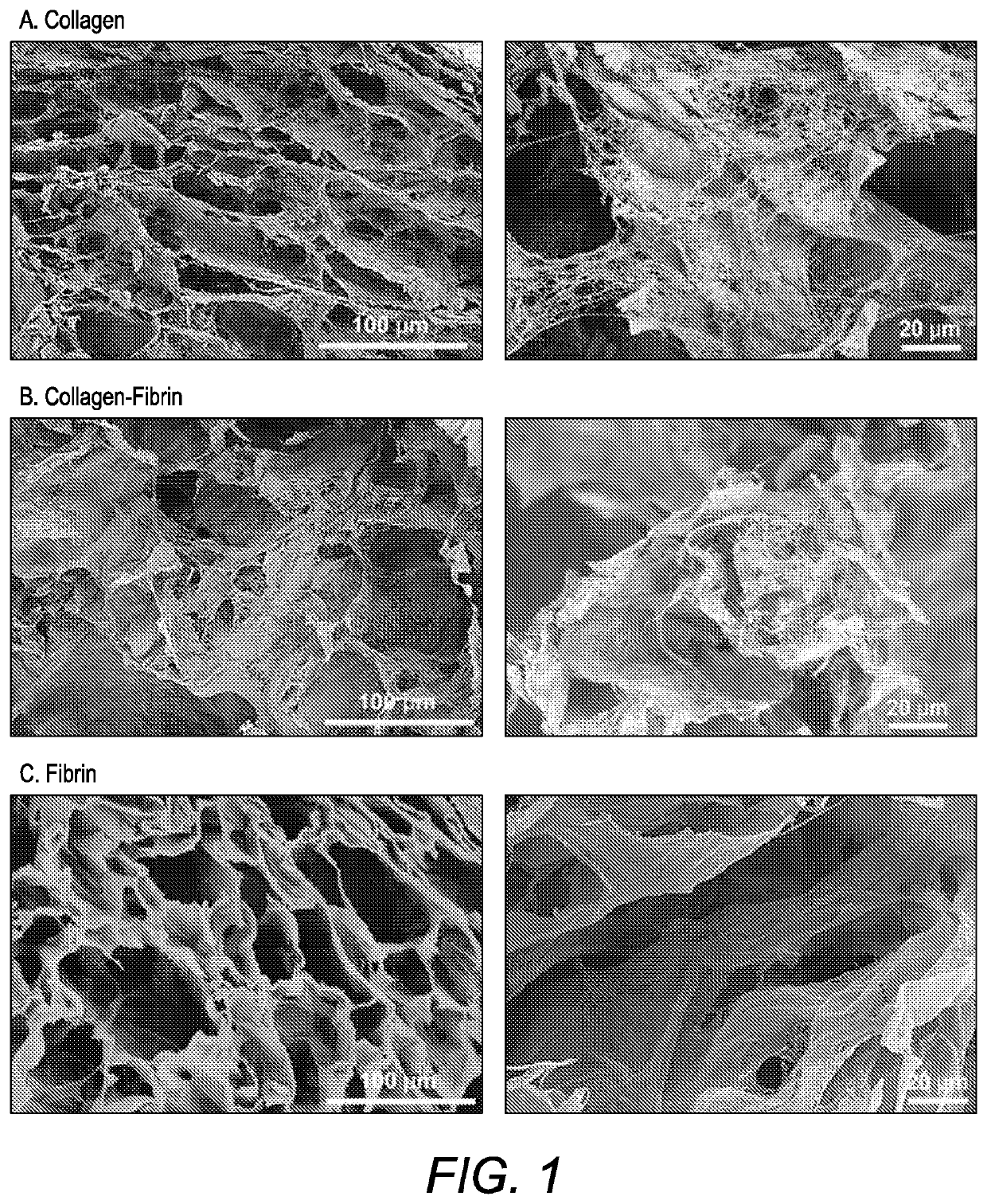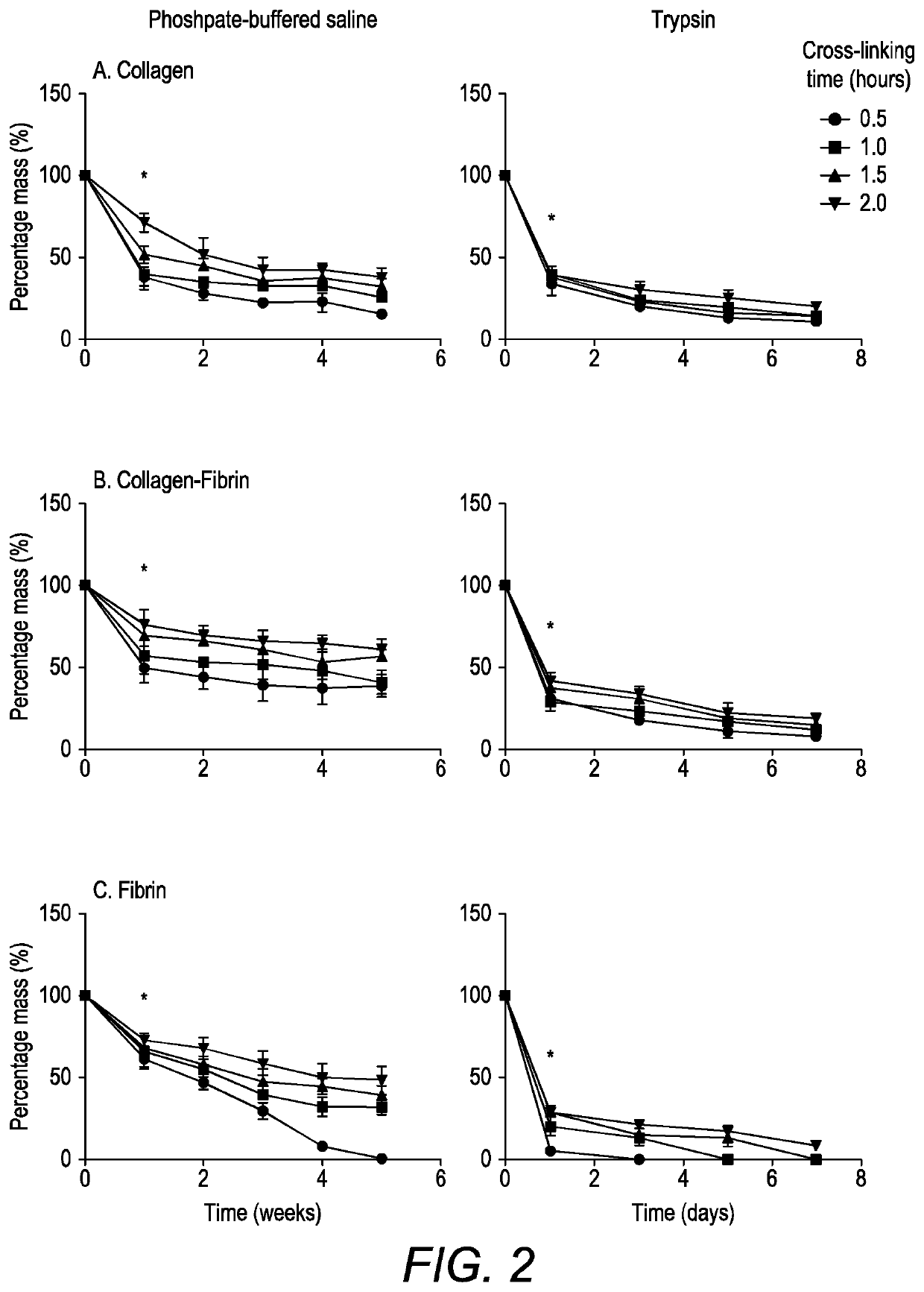Scaffold
a technology of scaffolds and spherical plates, applied in the field of scaffolds, can solve the problems of large pore defects, unable to achieve cellularisation and vascularisation of such materials, and a large number of lamellar structures
- Summary
- Abstract
- Description
- Claims
- Application Information
AI Technical Summary
Benefits of technology
Problems solved by technology
Method used
Image
Examples
example 2
ation Efficiency
Gelation
[0182]Emulsion mixtures were prepared for fibrin gellation systems.
[0183]Fibrinogen was dissolved to give a 2% solution of clottable protein in MES / NaCl buffer. The pH was adjusted to 7.4 after complete dissolution of the protein.
[0184]An emulsion mixture was prepared comprising 2 μl of calcium chloride, MES / NaCl, either up to 250 μl, decane 500 μl, and a test surfactant (in the range of 0.1 to 1% of decane volume).
[0185]Each of the emulsion mixtures were mixed by vortex and hand shaking so as to establish an emulsion. 250 μl Fibrinogen was added, and the mixture was briefly mixed again. Then 25 μl of thrombin was added, and the mixture was shaken vigorously for 30 seconds and incubated for 30 minutes at 37° C. Control tests of the aqueous components, calcium chloride, fibrinogen, MES / NaCl buffer and thrombin were run to verify coagulation.
TABLE 2Gellation results for fibrin gellation systemsCompositionTest mixEmulsionAqueousGellation resultControlNil1%...
example 3
Materials
[0187]Mineral oil, Tween 20 and Span 20, 2-(N-morpholino) ethanesulfonic acid (MES), sodium chloride (NaCl), Oil Red 0, bovine serum albumin (>95% purity), FITC-BSA and butanol were all purchased from Sigma. Polyvinylpyrrolidone (PVP) excipient (Kollidon KDF90) was obtained from BASF Pharmaceutical Co.
Emulsion Preparation
Effect of HLB Ratio on Emulsification
[0188]Tween 20 and Span 20 were mixed to obtain a range of HLB ratios of 9.5 to 14, since the relative HLB (rHLB) of mineral oil to form an oil-in-water emulsion is described as approximately 10.5. 0.75% of surfactant was added to 5 ml of mineral oil. 2% of PVP was added to 2.5 ml of 25 mM MES / 150 mM NaCl buffer (pH 7.4). The solution was vortexed for 15 seconds.
Effect of PVP Concentration on Emulsification
[0189]0.5% of Tween 20 / Span 20 surfactant mix with an HLB ratio of 13 was added to 5 ml of mineral oil. 0%, 0.5%, 2% and 4% of PVP was added to 2.5 ml of 25 mM MES / 150 mM NaCl buffer (pH 7.4). The solution was vortexed...
example 4
f Emulsion Template Size
Relationship Between Shear Rate, Surface Tension and Emulsion Droplet Size.
[0221]The control of the emulsion droplet size is a critical aspect of the invention. in a templating emulsion system the size of the oil-in-water droplet as a porogen or pore template directly and closely determines the pore size of resultant scaffolds.
[0222]Emulsion dispersions may be considered as intrinsically unstable. This is argued from the consideration of the stability of a pure oil phase with pure water. When shaken, an emulsion will be formed, although this will be unstable and will rapidly separate out. The introduction of a surfactant changes the thermodynamic stability, because the surfactant will lower the surface energy of the interface, and provide a stable boundary layer which opposes the force of separation from a mixture.
Theoretical Relationship.
[0223]The emulsion droplet pressure is given by the Laplace law. ΔPd=2γ / rd where the subscript d refers to the emulsion dr...
PUM
| Property | Measurement | Unit |
|---|---|---|
| diameter | aaaaa | aaaaa |
| vol % | aaaaa | aaaaa |
| molar concentration | aaaaa | aaaaa |
Abstract
Description
Claims
Application Information
 Login to View More
Login to View More - R&D
- Intellectual Property
- Life Sciences
- Materials
- Tech Scout
- Unparalleled Data Quality
- Higher Quality Content
- 60% Fewer Hallucinations
Browse by: Latest US Patents, China's latest patents, Technical Efficacy Thesaurus, Application Domain, Technology Topic, Popular Technical Reports.
© 2025 PatSnap. All rights reserved.Legal|Privacy policy|Modern Slavery Act Transparency Statement|Sitemap|About US| Contact US: help@patsnap.com



